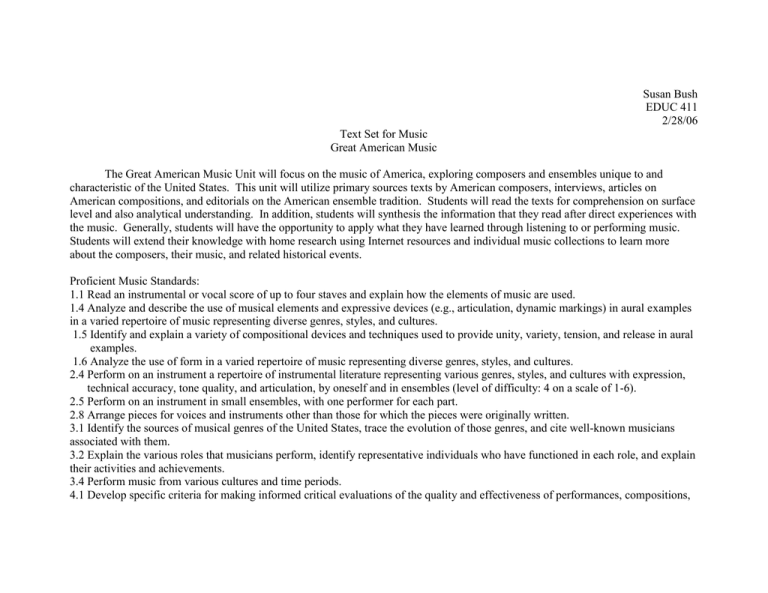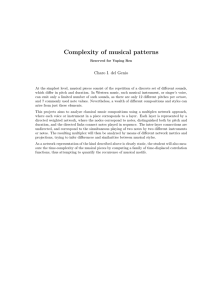Susan Bush EDUC 411 2/28/06 Text Set for Music
advertisement

Susan Bush EDUC 411 2/28/06 Text Set for Music Great American Music The Great American Music Unit will focus on the music of America, exploring composers and ensembles unique to and characteristic of the United States. This unit will utilize primary sources texts by American composers, interviews, articles on American compositions, and editorials on the American ensemble tradition. Students will read the texts for comprehension on surface level and also analytical understanding. In addition, students will synthesis the information that they read after direct experiences with the music. Generally, students will have the opportunity to apply what they have learned through listening to or performing music. Students will extend their knowledge with home research using Internet resources and individual music collections to learn more about the composers, their music, and related historical events. Proficient Music Standards: 1.1 Read an instrumental or vocal score of up to four staves and explain how the elements of music are used. 1.4 Analyze and describe the use of musical elements and expressive devices (e.g., articulation, dynamic markings) in aural examples in a varied repertoire of music representing diverse genres, styles, and cultures. 1.5 Identify and explain a variety of compositional devices and techniques used to provide unity, variety, tension, and release in aural examples. 1.6 Analyze the use of form in a varied repertoire of music representing diverse genres, styles, and cultures. 2.4 Perform on an instrument a repertoire of instrumental literature representing various genres, styles, and cultures with expression, technical accuracy, tone quality, and articulation, by oneself and in ensembles (level of difficulty: 4 on a scale of 1-6). 2.5 Perform on an instrument in small ensembles, with one performer for each part. 2.8 Arrange pieces for voices and instruments other than those for which the pieces were originally written. 3.1 Identify the sources of musical genres of the United States, trace the evolution of those genres, and cite well-known musicians associated with them. 3.2 Explain the various roles that musicians perform, identify representative individuals who have functioned in each role, and explain their activities and achievements. 3.4 Perform music from various cultures and time periods. 4.1 Develop specific criteria for making informed critical evaluations of the quality and effectiveness of performances, compositions, arrangements, and improvisations and apply those criteria in personal participation in music. 5.1 Explain how elements, artistic processes, and organizational principles are used in similar and distinctive ways in the various arts. Literacy/English Standards: 2.5 Extend ideas presented in primary or secondary sources through original analysis, evaluation, and elaboration. 2.6 Demonstrate use of sophisticated learning tools by following technical directions (e.g., those found with graphic calculators and specialized software programs and in access guides to World Wide Web sites on the Internet). 2.4 Deliver oral responses to literature: a. Advance a judgment demonstrating a comprehensive grasp of the significant ideas of works or passages (i.e., make and support warranted assertions about the text). b. Support important ideas and viewpoints through accurate and detailed references to the text or to other works. c. Demonstrate awareness of the author's use of stylistic devices and an appreciation of the effects created. d. Identify and assess the impact of perceived ambiguities, nuances, and complexities within the text. Text Colburn, Michael J. “John Williams Returns to Bands.” The Instrumentalist. June 2004 v. 58, n. 11 p 1217 Lesson Structure Students will read the interview. Students will perform or listen to William’s compositions Students will talk about what they heard in the music based on the article Students will Teachable Moments Extensions Assessment Students will find a Students will write about Students will movie or composition their observations in the learn about the recording at home and extension. Also, march genre and write about what they evaluation will take J.P. Sousa heard. (This includes, place orally in class Students will discussion. Mock study borrowed Harry Potter, Star Wars, Schindler’s List, etc.) Interviews can be grades music (Holst, Dvorak) Students will write about for comprehension of the what they heard. reading material. Students will discuss the film music genre Possibly the Holocaust in Porter, Keith. Four Musical Minimalists. Cambridge University Press: Cambridge 2000. p. 153-159 Agrell, Jeffrey. “The Creative Hornist.” The Horn Call. October 2005. v. XXXVI n. 1 p. 42-43. conduct MockInterviews as Williams. Students will perform Clapping Music or Music for Pieces of Wood. Students will read the article about Different Trains Students will listen to Different Trains Students will talk about what they heard Students will discuss Holocaust and WWII in America Students will read article. Students will write about ensemble ideas. Students will brainstorm as a studying Schindler’s List Discussion of Twentieth century technological techniques and advances in music Discussion of Minimalism Discussion of Holocaust and WWII in music Discussion of role of composer in history Study of the garage band, 60’s music, American Experimentalism Creativity in composition, Students will find a Students will write in the piece (modern, popular, extension activity. classical, etc) about war Students will be or conflict and write a evaluated in class paragraph about the discussion participation. musical devices used and socio-political context. Students will meet outside of class in their groups to rehearse a given skeletal piece, using unique instrumentation and improvising and In class writing can be evaluated for comprehension. Weiss, Piero; Taruskin, Richard; Ives, Charles. Excerpts from “From the writings of Charles Ives.” Music in the Western World. Schirmer Books: New York, 1984. p. 423-426 Williams, Mary. Readings on West Side Story. Greenhaven group about ensembles and how to get started Students will get into groups with friends for extension. Students will read the excerpt Students will listen to the original Charles Ives recording of “They are There!” as well as the choral recording Students will analyze Ives’s own recording using the ideas in the reading- this will be a written assignment. Students will discuss Students will read the article Students will improvisation Teamwork and collaborative skills arranging the work. Students will present this in the next class. World War II and Vietnam The American Experimentalist Movement Traditional American folk and patriotic music and its applications and associations The concept of the musical as the consumer and producer of music Students will find a patriotic or folk song from America or their other cultural heritage. They will write about when they first remember hearing this music and what it reminds them of currently. Student writings in class and extension can be evaluated for comprehension. Students will find a piece of music that relates to social conflict, Student writing can be evaluated in extension. Student comprehension Discussion on historical and current social Press: San Diego, 2001. p. 69-76 watch portions of the filmed musical Students will analyze musical qualities (fugue, 12 tone, etc.) Students will discuss social/cultural conflict, identifying current conflict and historic conflict and cultural including urban youth conflict in the gang issues. Students USA will write a paragraph on Learn about 12- the musical devices and the message of the tone technique, music. fugue and invention form. Learn about modern musical form, with modern influences and musical device understanding will be assessed using question and answer in the classroom.


